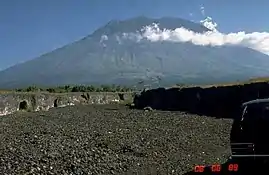Karangasem Regency
Karangasem Regency (Indonesian: Kabupaten Karangasem) is a regency (kabupaten) of Bali, Indonesia. It covers the east part of Bali, has an area of 839.54 km2 and had a population of 396,487 at the 2010 Census;[4] the latest official estimate (as at mid 2019) is 416,600.[5]. Its regency seat is Amlapura. Karangasem was devastated when Mount Agung erupted in 1963, killing 1,900 people. Karangasem was a kingdom before Bali was conquered by the Dutch.
Karangasem Regency
Kabupaten Karangasem ᬓᬩᬸᬧᬢᬾᬦ᭄ᬓᬭᬂᬳᬲᭂᬫ᭄ | |
|---|---|
 Coat of arms | |
| Motto(s): Raksakeng Dharma Prajahita English: "Blessing Protection of Dharma to Achieve People's Welfare" | |
 Location of Karangasem Regency in Bali | |
| Coordinates: 8°23′S 115°31′E | |
| Country | |
| Province | |
| Capital | Amlapura |
| Government | |
| • Regent | I Gusti Ayu Mas Sumatri |
| Area | |
| • Total | 324.15 sq mi (839.54 km2) |
| Elevation | 289 ft (88 m) |
| Population | |
| • Total | 416,600 |
| • Density | 1,300/sq mi (500/km2) |
| Time zone | UTC+8 (Indonesia Central Time) |
| Area code | (+62) 363 |
| Vehicle registration | DK |
| Website | karangasemkab.go.id |
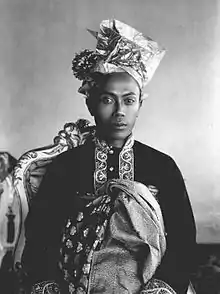
Administrative districts
The regency is divided into eight districts (kecamatan), tabulated below with their areas and population totals from the 2010 Census[6] and the official estimates for mid 2019.[7] The table also includes the number of administrative villages (rural desa and urban kelurahan) in each district, and its postal codes.
| Name | Area in km2 | Population Census 2010[8] | Population Estimate mid 2019[9] | Number of villages | Post codes |
|---|---|---|---|---|---|
| Rendang | 109.70 | 36,931 | 40,230 | 6 | 80863 |
| Sidemen | 35.15 | 31,617 | 33,290 | 10 | 80864 |
| Manggis | 69.83 | 44,041 | 45,930 | 12 | 80871 |
| Karangasem (district) (a) | 94.23 | 82,606 | 88,600 | 11 | 80811 -80813 |
| Abang | 134.05 | 60,965 | 62,910 | 14 | 80852 |
| Bebandem | 81.51 | 45,160 | 46,390 | 8 | 80861 |
| Selat | 80.35 | 38,114 | 39,860 | 8 | 80862 |
| Kuku | 234.72 | 57,053 | 59,390 | 9 | 80853 |
| Totals | 839.54 | 396,487 | 416,600 | 76 |
Note: (a) including 6 offshore islands.
Tourism

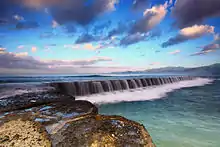
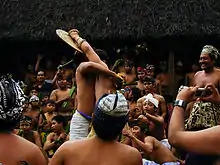

Interesting places include:
- The major Pura Besakih Hindu temple, sometimes called the Mother Temple of Besakih.
- Mount Agung, the highest peak in Bali
- Telaga Waja River, the only rafting spot at eastern Bali
- Tenganan "the original Bali", a Bali Aga village whose inhabitants who still live according to their ancient traditions
- Amed, a beach town.
- Tulamben, a dive site
- Candidasa, a starting point for visiting the east coast of Bali. East of Candidasa is the village of Bugbug, whose inhabitants celebrate the Perang Dawa (war of the gods) every other year on the full moon of the fourth month, October.
- Prasi Beach in Prasi village, known as Pantai Pasir Putih "White Sandy Beach)" and also as Virgin Beach. Its white sandy beaches are mainly free of crowds, less polluted, and popular for swimming or snorkeling from April to October. [10] [11]
- Ujung Water Palace, built by the King Anak Agung Agung Anglurah Ketut Karangasem.
- Tirta Gangga water palace
- Puri Agung Karangasem, collectively several royal palaces of the Karangasem kingdom[12]
- Budakeling, an area where both Hindus and Muslims live. Saren Jawa village is home to 100 Muslim families, surrounded by Balinese Hindu villages following the Siwa-Buda belief system, which is a combination of Hinduism and Mahayana Buddhism. The people of Saren Jawa use Balinese first names before their Muslim last names, such as Ni Nyoman Maimunah.[13]
- Seraya Village, which keeps the Gebug Ende tradition related to scarcity of water during drought season[14]
- Mencol Hill, the eastern-most hill on Bali island. It is known as a sunrise viewpoint; the temple at the peak of the grassy hill has a view to the east coast and Gili Selang islet.[15]
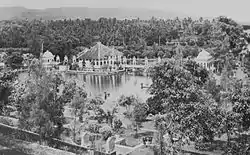
References
- :BPS Provinsi Bali:
- "Karangasem in Figures 2017". Badan Pusat Statistik Karangasem. Retrieved July 20, 2018.
- Badan Pusat Statistik, Jakarta, 2020.
- Biro Pusat Statistik, Jakarta, 2011.
- Badan Pusat Statistik, Jakarta, 2020.
- Biro Pusat Statistik, Jakarta, 2011.
- Badan Pusat Statistik, Jakarta, 2020.
- Biro Pusat Statistik, Jakarta, 2011.
- Badan Pusat Statistik, Jakarta, 2020.
- Wayan Suadnyana. "Bali White Sand Beach". Retrieved August 24, 2014.
- Adji Soedibjo. "Pantai Pasir Putih: Bali's Virgin Beach". Archived from the original on July 25, 2013. Retrieved February 19, 2015.
- "Puri Agung Karangasem Royal Palace". July 20, 2018.
- "Saren Jawa — a model of harmony". August 25, 2011.
- "Gebug Ende or Gebug Seraya". July 20, 2018.
- "Mencol". July 18, 2018.
External links
![]() East Bali travel guide from Wikivoyage
East Bali travel guide from Wikivoyage
- Official site (new) (in Indonesian)
- Official site (old) (in Indonesian)
| Wikimedia Commons has media related to Karangasem. |
